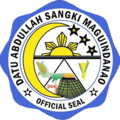Datu Abdullah Sangki | |
|---|---|
| Municipality of Datu Abdullah Sangki | |
 Municipal Hall | |
 Map of Maguindanao del Sur with Datu Abdullah Sangki highlighted | |
Location within the Philippines | |
| Coordinates: 6°47′49″N124°32′05″E / 6.797033°N 124.534644°E | |
| Country | Philippines |
| Region | Bangsamoro Autonomous Region in Muslim Mindanao |
| Province | Maguindanao del Sur |
| District | Lone district |
| Founded | January 3, 2004 |
| Barangays | 10 (see Barangays) |
| Government | |
| • Type | Sangguniang Bayan |
| • Mayor | Suharto Al Wali S. Mangudadatu |
| • Vice Mayor | Samsodhen A. Sangki |
| • Representative | Mohamad P. Paglas Sr. |
| • Municipal Council | Members |
| • Electorate | 33,228 voters (2025) |
| Area | |
• Total | 220.00 km2 (84.94 sq mi) |
| Elevation | 76 m (249 ft) |
| Highest elevation | 737 m (2,418 ft) |
| Lowest elevation | 20 m (70 ft) |
| Population (2020 census) [3] | |
• Total | 30,117 |
| • Density | 140/km2 (350/sq mi) |
| • Households | 4,958 |
| Economy | |
| • Poverty incidence | 25.37 |
| • Revenue | ₱ 194.4 million (2022) |
| • Assets | ₱ 222.7 million (2022) |
| • Expenditure | ₱ 171.7 million (2022) |
| • Liabilities | ₱ 78.01 million (2022) |
| Service provider | |
| • Electricity | Maguindanao Electric Cooperative (MAGELCO) |
| Time zone | UTC+8 (PST) |
| ZIP code | 9609 |
| PSGC | |
| IDD : area code | +63 (0)64 |
| Native languages | Maguindanao Tagalog |
| Website | www |
Datu Abdullah Sangki, officially the Municipality of Datu Abdullah Sangki (Maguindanaon: Ingud nu Datu Abdullah Sangki; Iranun: Inged a Datu Abdullah Sangki; Tagalog : Bayan ng Datu Abdullah Sangki), is a municipality in the province of Maguindanao del Sur, Philippines. According to the 2020 census, it has a population of 30,117 people. [3]
Contents
The municipality was created under Muslim Mindanao Autonomy Act No. 153, passed by the Regional Legislative Assembly on August 15, 2003, and approved on August 20, 2003, [5] ratified in the plebiscite held on January 3, 2004. [6] It was carved out from its mother town, Ampatuan. The MMA law creating the municipality provides that its administrative center shall be established in barangay Talisawa.



